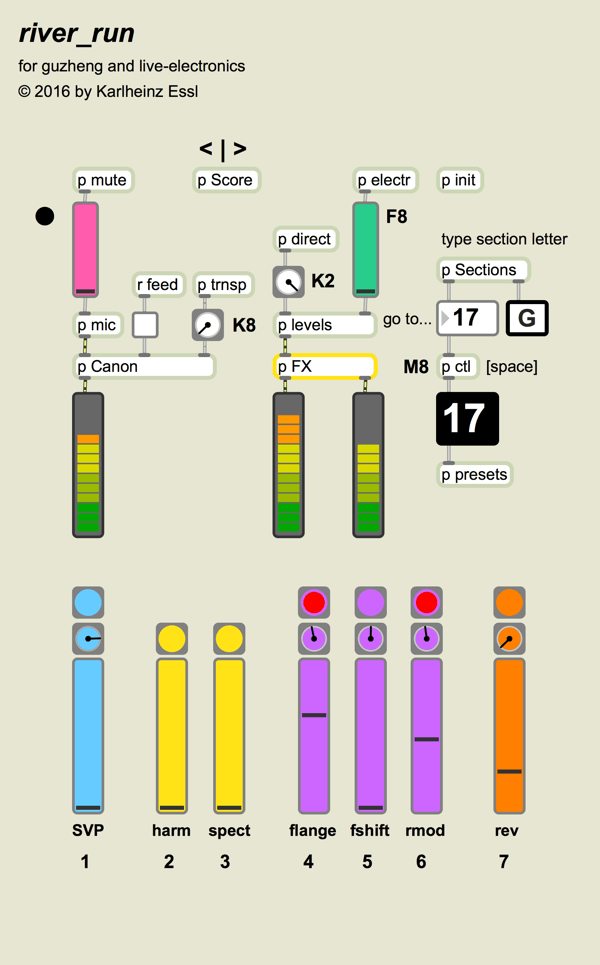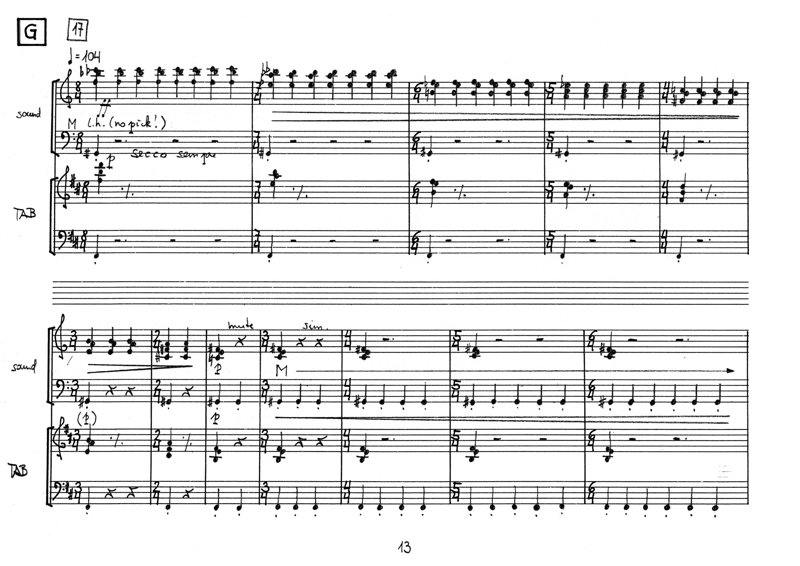river_run
for guzheng and live-electronicsDedicated to Ming Wang
2016
alternative version for harp and live-electronics
2018
Basics | Introduction | Requirements | Scores | Software | Listen | Literature | Performances
alternative version for harp and live-electronics
2018
Basics | Introduction | Requirements | Scores | Software | Listen | Literature | Performances
riverrun
past Eve and Adam's
from swerve of shore to bend of bay
1
river_run, performed by Ming Wang und Karlheinz Essl
Musiikkitalo, Camerata Hall (Helsinki, 28 Oct 2016)
Diese Komposition ist die Weiterführung meiner Beschäftigung mit der chinesischen Musikkultur, die ich 2015 mit Autumn’s Leaving für Pipa und Live-Elektronik begonnen hatte. Im Zentrum steht nun die Guzheng, ein Zupfinstrument mit 21 Saiten, dessen charakteristischer „Sound” durch eine pentatonischen Stimmung geprägt ist. Die daraus - zwangsläufig - resultierenden Klangklischees und den mit ihnen transportierten Exotismus wollte ich unter allen Umständen strategisch vermeiden - durch zwei gezielte Interventionen:
Dieses hybride und äußerst labile Setting erzeugt ein sanft schwingendes System aus Instrument und Elektronik, Westen und Osten, Nähe und Ferne, Alt und Neu. Manchmal werden Erinnerungen an Schubert, Mahler, Berg und Deep Purple an die Oberfläche gespült, um sofort wieder im Strom der Klänge unterzutauchen.
![]()
The Guzheng is an old Chinese instrument with 21 plucked strings. Its characteristic sound is strongly determined by a pentatonic tuning which evokes numerous clichés. In order to avoid them, I created an uncommon scordatura that combines Asian pentatonic with European chromaticism. Thanks to the live-electronics, the sound of the Guzheng can be transformed from orchestral aggregations to bell-like timbres.
These interventions generate an unstable equilibrium between instrument and electronics, East and West, old and new. At certain points, memories of Schubert, Mahler, Berg and Deep Purple float to the surface before they are washed away by the stream of sounds.
![]()
流淌的河流
Karlheinz Essl
流淌的河流 (2016) 古箏 与 电子音乐
“2015年开始我尝试了琵琶与电子音乐融合的作品《秋逝》,从那之后我一直关注中国的音乐文化,这次的重点是古筝,古筝是一种有 21 根弦的弹拨乐器,有其特有的以五声音阶为特征的音韵。这就使得古筝音乐给人留下一成不变和异域风情的印象,为了尽可能避免这样的刻板印象,我想用两种针对性的方式予以干预:
1. 一种特殊的调音方式将亚洲的五声音阶和西方的半声音阶组合在一起,创建了一个扩展的混音参考系统。
2. 现场的电子音乐不仅在声音方面丰富了古筝;它还会在很大程度上影响乐曲的结构,有时会产生管弦乐或钟声的效果。
这种混合且极其不稳定的设置创造了一个由古筝和电子音乐融合,贯通东西,囊括远近,包容新旧的悠扬音响系统。有时会让人想起舒伯特,马勒,贝尔格和深紫乐队,但这些涌起的记忆又很快消失在音乐的海洋中。
Einführung in river_run von Karlheinz Essl
Alte Schmiede (Wien, 14 Oct 2016)
Zur Entstehung von river_run
Podiumsdiskussion Writing Music mit Iris ter Schiphorst, Johannes Maria Staud,
Johannes Kreidler und Karlheinz Essl; Moderation: Bernhard Günther
Musikuniversität Wien (26 Jan 2017)
Karlheinz Essl explains how he approached the ancient Chinese instrument guzheng
Interdisziplinäre Ringvorlesung Transkulturalität_mdw: "Music in the Diaspora - China and Taiwan"
Musikuniversität Wien (6 Dec 2017)
Studio recording of river_run
Studio kHz (29 Sep 2016)

In the upper staff, the resulting sounds are written. In the staff below you see a tabulature referring to a pentatonic tuning based on D.

Software for the live-electronics, written in Max
© 2016 by Karlheinz Essl
The scores of river_run - for guzheng or harp - can be downloaded for free. Please note that the music is protected by copyright.

Excerpt from Karlheinz Essl's river_run (2016)
© 2016 by Karlheinz Essl

Excerpt from Karlheinz Essl's river_run (2016)
© 2016 by Karlheinz Essl

Excerpt from Karlheinz Essl's river_run (2016)
© 2016 by Karlheinz Essl
| Home | Works | Sounds | Bibliography | Concerts |
Updated: 18 May 2025